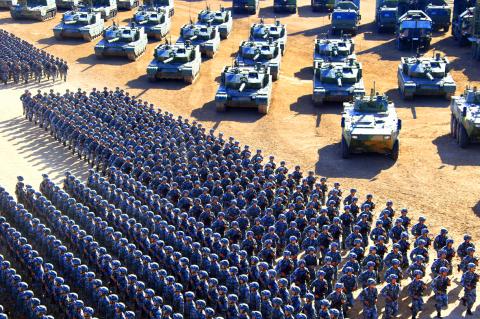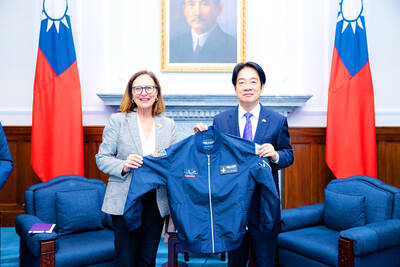Chinese President Xi Jinping (習近平) yesterday told the military to transform itself into an elite force as he oversaw a parade with flybys of advanced jets and a mass rally of troops to mark 90 years since the founding of the Chinese People’s Liberation Army (PLA).
China’s armed forces, the world’s largest, are in the midst of an ambitious modernization program, which includes investment in technology and new equipment such as stealth fighters and aircraft carriers, as well as cuts to troop numbers.
Xi presided over the large-scale military parade at the remote Zhurihe Training Base in the Inner Mongolia Autonomous Region, where he inspected troops from the back of a jeep, an event carried live on state television.

Photo: Xinhua via AP
Xi, who oversees the PLA in his role as head of the powerful Chinese Central Military Commission, repeatedly shouted “Hello comrades” and “Comrades, you are working hard” into four microphones fixed atop his motorcade as martial music blared in the background.
Tanks, vehicle-mounted nuclear-capable missiles and other equipment rolled by as military aircraft flew above, including H-6K bombers — which have been patrolling near Taiwan and Japan — the J-15 carrier-based fighters and the new generation J-20 stealth fighter.
“Today, we are closer to the goal of the great rejuvenation of the Chinese nation than any other time in history and we need to build a strong people’s military more than any other time in history,” Xi told the assembled troops in a short speech that did not yield any policy announcements.
Xi said that the military must “unswervingly” back the Chinese Communist Party.
“Always listen to and follow the party’s orders and march to wherever the party points,” he said.
Xi said that the world was not peaceful, but he did not mention any specific hot spots, such as territorial disputes in the South China Sea, Taiwan or tensions over North Korea’s nuclear weapons and missiles programs.
It was the first time China has marked Army Day on Aug. 1 with a military parade since the Communist revolution in 1949, state news agency Xinhua said.
It was also the first time Xi has reviewed troops in the field like this, Xinhua added.
The location for the parade embodied a “dust-covered battlefield atmosphere” for the 12,000 troops who participated, Chinese Ministry of National Defense spokesman Ren Guoqiang (任國強) said in a statement.
The nation’s military is more nimble and technologically proficient following reforms to make it more compact and responsive, and less reliant on its troop numbers, Xi said last week.
China has not fought a war in decades and the government insists it has no hostile intent, but simply needs the ability to properly defend what is now the world’s second-largest economy.

RESPONSE: The transit sends a message that China’s alignment with other countries would not deter the West from defending freedom of navigation, an academic said Canadian frigate the Ville de Quebec and Australian guided-missile destroyer the Brisbane transited the Taiwan Strait yesterday morning, the first time the two nations have conducted a joint freedom of navigation operation. The Canadian and Australian militaries did not immediately respond to requests for comment. The Ministry of National Defense declined to confirm the passage, saying only that Taiwan’s armed forces had deployed surveillance and reconnaissance assets, along with warships and combat aircraft, to safeguard security across the Strait. The two vessels were observed transiting northward along the eastern side of the Taiwan Strait’s median line, with Japan being their most likely destination,

‘NOT ALONE’: A Taiwan Strait war would disrupt global trade routes, and could spark a worldwide crisis, so a powerful US presence is needed as a deterrence, a US senator said US Senator Deb Fischer on Thursday urged her colleagues in the US Congress to deepen Washington’s cooperation with Taiwan and other Indo-Pacific partners to contain the global security threat from China. Fischer and other lawmakers recently returned from an official trip to the Indo-Pacific region, where they toured US military bases in Hawaii and Guam, and visited leaders, including President William Lai (賴清德). The trip underscored the reality that the world is undergoing turmoil, and maintaining a free and open Indo-Pacific region is crucial to the security interests of the US and its partners, she said. Her visit to Taiwan demonstrated ways the

GLOBAL ISSUE: If China annexes Taiwan, ‘it will not stop its expansion there, as it only becomes stronger and has more force to expand further,’ the president said China’s military and diplomatic expansion is not a sole issue for Taiwan, but one that risks world peace, President William Lai (賴清德) said yesterday, adding that Taiwan would stand with the alliance of democratic countries to preserve peace through deterrence. Lai made the remark in an exclusive interview with the Chinese-language Liberty Times (sister paper of the Taipei Times). “China is strategically pushing forward to change the international order,” Lai said, adding that China established the Asia Infrastructure Investment Bank, launched the Belt and Road Initiative, and pushed for yuan internationalization, because it wants to replace the democratic rules-based international

RELEASED: Ko emerged from a courthouse before about 700 supporters, describing his year in custody as a period of ‘suffering’ and vowed to ‘not surrender’ Former Taiwan People’s Party (TPP) chairman Ko Wen-je (柯文哲) was released on NT$70 million (US$2.29 million) bail yesterday, bringing an end to his year-long incommunicado detention as he awaits trial on corruption charges. Under the conditions set by the Taipei District Court on Friday, Ko must remain at a registered address, wear a GPS-enabled ankle monitor and is prohibited from leaving the country. He is also barred from contacting codefendants or witnesses. After Ko’s wife, Peggy Chen (陳佩琪), posted bail, Ko was transported from the Taipei Detention Center to the Taipei District Court at 12:20pm, where he was fitted with the tracking